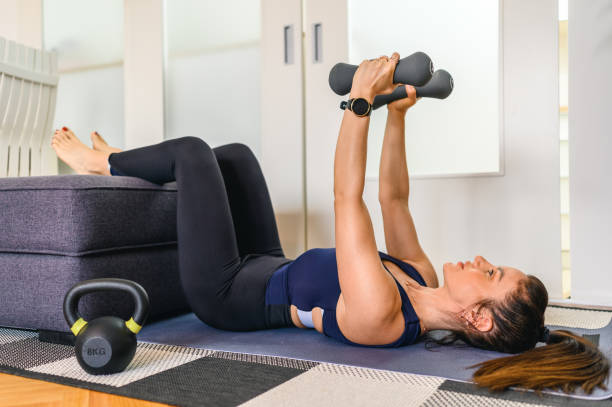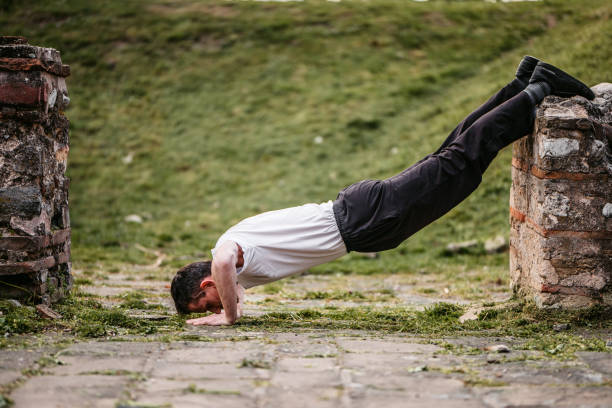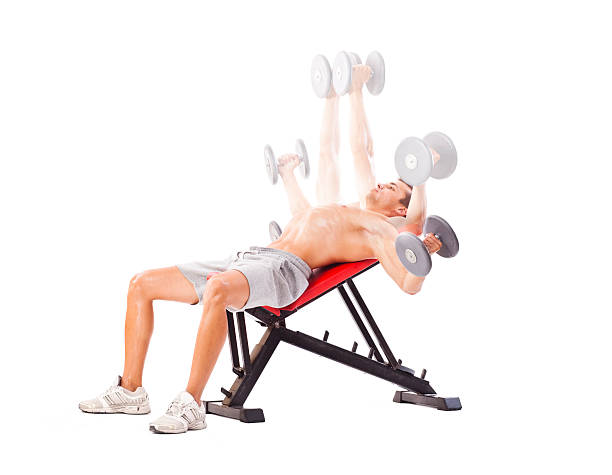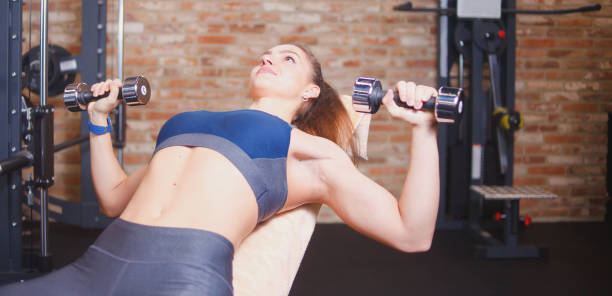
Introduction to Incline Bench Press Alternatives
The incline bench press is a popular chest exercise that targets the upper portion of the pectoral muscles, but what if you don’t have access to a bench? Don’t worry; some alternatives can effectively work your chest muscles without any specialized equipment. This article will explore different ways to do an incline press in the comfort of your home or gym.
Why consider alternatives to the incline bench press?
Using different exercises can help prevent boredom and stimulate muscle growth. If you only perform one exercise for your chest regularly, your body will adapt and eventually plateau. Incorporating new movements or tweaking existing ones can challenge your muscles and help break through plateaus.
Benefits of incorporating different exercises in your chest workout
Mixing up your chest workout has numerous benefits beyond just preventing boredom. By targeting different angles of the pecs, you can develop a well-rounded, aesthetically pleasing chest while addressing potential muscle imbalances. Additionally, working with varied weights and resistance levels during each movement can increase strength in both major and minor muscle groups.
How to Perform Incline Dumbbell Presses Without a Bench
Using an exercise ball or stacked pillows as a makeshift bench
One way to replicate an incline bench press at home is to use an exercise ball or stacked pillows as a makeshift bench. To start, sit on the ball or lean against the pillows with feet planted firmly on the ground for stability. Hold dumbbells at shoulder height with palms facing away from you. Slowly lower weights down until elbows are level with shoulders before pushing back up to starting position.
Proper form and technique for safety and effectiveness
Maintain natural curvature of the spine throughout the entire movement (avoid hunching forward). Shoulders should be retracted back towards hips throughout the entire motion, keeping them away from ears/chest during the contraction phase (the point at which weight is lifted). Gradually lower dumbbells until upper arms parallel the ground before pressing back up through the heels and glutes.
Flat Bench vs. Incline Bench: Which Should You Start With?
Differences in muscle activation and target areas
The primary difference between a flat and incline bench press lies in the degree of incline. While a flat bench targets overall chest development, an incline hits the upper portion of pectoral muscles primarily. However, both variations work the triceps, shoulders, and minor muscle groups to some extent.
Pros and cons of each exercise
Both exercises have their pros and cons. The flat bench press can help develop overall strength while also positively influencing powerlifting movements like squats or deadlifts. The incline bench press helps sculpt a well-rounded chest by focusing on developing upper pecs aesthetically pleasing to most people.
Reasons to Substitute the Incline Dumbbell Press
Limited equipment availability
Some gyms may not have an incline bench or only one limiting schedule flexibility. Home gym enthusiasts also need space constraints that make it impractical or impossible to add an incline bench. Alternate methods (described below) meet similar objectives despite limited access.
Preventing workout plateaus
Switching up exercises can prevent boredom but also stimulate muscle growth more effectively over time because different exercises will stress different planes of motion differently than others increasing stimulus from multiple angles/stimulus intensities throughout cycles which keeps your body’s metabolism engaged.
Addressing muscle imbalances
Working one side at a time can help address any asymmetries you might be experiencing in your chest muscles (also called unilateral training). Incorporating single-arm movements with dumbbells specifically targets each side independently, allowing you to fine-tune strength discrepancies between left & right pecs along secondary muscles like biceps/trapezius/etc. as well, for symmetry’s sake!
Performing Low to High Cable or Band Flye as an Alternative
Setting up cables or bands at the correct height
To perform a low-to-high cable or band fly, it’s essential to attach equipment at the appropriate height. Select a weight that challenges you but is light enough so your form remains intact. Grab the handles while facing away from the machine/band and step forward until your arms are extended in front of the chest.
Proper form and technique
Maintain natural curvature of the spine throughout the entire movement (avoid hunching forward). Keep elbows elevated during the entire motion by pinning them to the sides of the body/ribs upon the contraction phase. Sweep hands together above the head, squeezing chest at the top position before lowering weights under control down to starting point.
Benefits of cable or band flyes over dumbbell presses
Cable and band flies allow for more consistent tension throughout the entire range of motion as pulleys keep resistance constant despite their location in space, unlike gravity’s variable application based on distance found in free weights. Cables also offer both negative-resistance (eccentric) portions allowing maximal stimulation without compromising muscle/joint integrity, preventing injury risks.

Mastering Incline Chest Press With Resistance Bands
Selecting the appropriate resistance band
Resistance bands can replicate an incline bench press with less risk of injury than other methods since you’ll be working with lighter loads, thus reducing any possible overuse injuries caused by repetitive heavy-weight lifting motions. First, select a band that corresponds appropriately with your fitness level (as well as includes adequate handles for easy attachment). Attach it securely to something stable, like a door or post, before proceeding.
Correct setup and positioning
While standing perpendicular to where you have anchored the resistance bands, hold onto each handle and step back far enough so that when arms are fully extended overhead, span long enough between handles, creating proper anchoring/setup orientation, etc.
Proper form and technique for maximum muscle engagement
To begin safely, contract your shoulder blades down & back before bending your elbows. Lower handles down to the center of the chest and squeeze at the top briefly (ensure the scapula is stable) before extending handles back up due to active effort by contracting pectoral muscles throughout the movement. Control resistive descent, ensuring tension remains on both ends of each rep while not allowing the band to jerk/otherwise disrupt form.
How to Perform Decline Push-Ups for Chest Development
Push-ups are a classic bodyweight exercise that can be done anywhere and requires no equipment. They also offer several variations that target different muscle groups, such as decline push-ups that focus on the upper and lower chest muscles.
To perform decline push-ups:
• Place your feet on a raised surface like a step or sturdy chair.
• Position your hands slightly wider than shoulder-width apart with your fingers pointing forward.
• Maintain a straight line from your head to your heels by engaging your core and squeezing your glutes.
• Bend your elbows and lower yourself towards the ground until your chest almost touches it.
• Press back up explosively until you reach the starting position.
You can progress this movement by elevating your feet higher or placing them closer together. Alternatively, make it easier by performing regular push-ups instead.
Programming an Incline Dumbbell Press Alternative into Your Routine
Before incorporating any new exercise into your workout routine, it’s crucial to identify your fitness goals and balance out pushing movements with pulling exercises for overall shoulder health.
For example, if you’re looking to build strength and size in your upper chest muscles, consider adding one of these exercises to an existing chest workout:
• Incline Push-Up Variations
Progressions: Elevate feet slight bend; higher; narrow hand positioning
Regressions: Lowering feet; wider hand positioning
• Landmine Chest Presses
Progressions: Increasing weight; adding a pause at the bottom range of motion
Regressions: Reducing weight; shortening range of motion
• Reverse-Grip Rotational Dumbbell Presses
Progressions: Increasing weight; slowing down movement tempo
Regressions: Reducing weight, increasing reps
Technique Tips for Incline Dumbbell Flyes
Incline dumbbell flies are another excellent exercise for targeting the upper chest muscles. To perform this exercise:
• Lie on a flat bench with your feet firmly planted.
• Hold two dumbbells directly above your shoulders, palms facing each other and elbows slightly bent.
• Slowly lower the weights to the sides until they reach shoulder level or slightly below.
• Bring them back up explosively to the starting position.
Here are some technique tips to keep in mind:
• Choose an appropriate weight that you can lift with proper form.
• Maintain control throughout the entire range of motion and avoid using momentum.
• Keep your arms slightly bent to reduce strain on your joints.

The Decline Push-Up: A Temporary Incline Dumbbell Press Substitute
If you need an incline exercise but don’t have access to any equipment or surfaces, decline push-ups offer similar benefits as incline dumbbell presses.
To perform decline push-ups:
• Start in a push-up position with your feet on a sturdy surface.
• Place your hands shoulder-width apart or slightly wider if it’s more comfortable for you.
• Bend both elbows simultaneously and slowly lower yourself towards the ground until you almost touch it.
• Push yourself back up explosively until reaching starting position.
Benefits of decline push-ups compared to incline dumbbell presses:
1. Fewer injuries – With no heavy weights and less pressure placed onto joints over time, there will be fewer chances for injury when attempting declines.
2. Increased core strength – Decline push-ups force your core muscles to work harder than they normally would during a regular push-up as your feet elevated on a surface makes things much more difficult
3. Improved overall muscle activation – Decline push-ups activate more muscles in the back, chest, and arms than traditional incline presses do, potentially leading to greater hypertrophy.
Exploring Adjustable Incline Bench Alternatives
If you have access to a bench that can adjust its incline angle up to 45 degrees (such as an adjustable weight bench), then this is the most effective way to perform an incline press.
However, if you don’t own one or have access to one of these types of benches, there are still ways you can mimic an incline angle and achieve a similar movement pattern:
• Using A Decline Bench: If one side of the adjustable bench top can be adjusted independently from the other end, so it slopes downwards, then using it upside down will give you another better alternative for dips.
• Homemade Incline Bench Options: You can create makeshifts by placing some thick pillows at an inclining angle next to a sturdy platform on which you’ll lie down, with your hips resting comfortably atop the blankets/pillows.
Two More Free Weight Incline Dumbbell Press Alternatives
Lastly are two other free-weight alternatives that simulate the range-of-motion and or difficulty level of the incline dumbbell press:
• Landmine Chest Presses
To execute landmine chest presses properly: Anchor one end of an Olympic barbell into any holder while standing perpendicularly alongside it; Pick up the opposite (free) end in one hand; Bring a medicine ball with two hands across your chest until both elbows are bent behind the ball; Extend further away from center axis till almost straight out and bring back slowly.
• Reverse-Grip Rotational Dumbbell Presses: This twist on a traditional incline press to the mix can provide a new challenge to muscle groups that haven’t been focused on as much.
To perform them correctly:
• Begin by lying down on an incline bench with your feet planted firmly on the ground.
• Hold two dumbbells with palms facing up, thumbs wrapped around the handle, and positioned directly above your shoulders.
• Slowly lower the weights out to the sides until they reach shoulder level or slightly below.
• Fully extend arms and rotate wrists so palms face towards feet
• Push upward, extending your arms further while you rotate your wrist inward until you get back to starting position.
Incorporating these moves into your chest workout will challenge your body in new ways and help break through plateaus where you previously were only seeing slow results.
Incline Swiss Ball Dumbbell Press: An Effective Alternative
Swiss ball dumbbell presses are beneficial due to their unstable nature requiring subtle adjustments from core muscles throughout each repetition, thus inviting core engagement along with chest muscles.
Selecting The Appropriate Swiss Ball Size
The selection of ball size is essential when conducting this workout. It’s important to select the appropriate size according to body weight. If your ball wobbles too much, eventually causing instability and poor form, you will not get out of it what you put in otherwise (certainly worth adopting!)
Proper Setup And Positioning For Safety And Effectiveness
Start off lying on top of an exercise ball placed at the lower-middle back section and hold two dumbbells, one on either side just above chest level. Begin by establishing balance before commencing movement using slow, consistent breathing practice while exhaling forcefully during the upward press phase – equally important is slowly returning to starting position without letting momentum take over completely at any time during the execution period.
Benefits Of Swiss Ball Presses Compared To Incline Bench Presses
Working with a Swiss ball will force you to work on your balance, improve coordination and engage another muscle group, such as the inner thighs. Other isolation-type exercises for optimal results best accompany it.

Incline Dumbbell Fly: Technique and Benefits
The incline dumbbell fly targets the same muscles as an incline bench press but requires no specialized equipment. Here’s how to perform this exercise:
– Lie on a mat or flat surface with your feet planted on the ground.
– Hold two dumbbells with palms facing each other and arms extended over your chest.
– Slowly lower both weights towards your sides until they align with your chest.
– Return to starting position by squeezing through your pectoral muscles.
Benefits: The incline dumbbell fly is ideal for targeting the often-neglected upper chest muscles and improving the muscular balance between the upper and lower parts of the chest. Additionally, it stretches shoulder joints and promotes mobility in this area.
Incline Cable Flyes: Another Incline Dumbbell Press Alternative
Cable machines can be ideal when you don’t have access to a bench but still want to work on incline flies. Here’s how to set up and perform cable flyes:
– Set up the cable machine at an angle (40-60 degrees) or use an adjustable pulley system if available.
– Stand facing the machine with one leg forward for more stability..
– Grasp two handles attached from opposite sides of the cable machine with palms facing each other at shoulder height
– Slowly squeeze handles together before your body until they come together while keeping elbows slightly bent.
Benefits: Cable flies create unique resistance profiles, allowing for a more nuanced stimulus to the body. They engage the inter-costal muscles and serratus anterior, which are important in stabilizing scapulae and should not be neglected.
Performing Low-to-High Cable Flyes: Tips and Benefits
Here’s how to perform low-to-high cable flyes:
– Stand with your feet positioned shoulder-width apart, palms facing forward on a cable machine.
– Grasp two handles from opposite sides of the machine at ankle height
– Bring both hands smoothly up overhead, following the path of an arch while squeezing through your pectorals. Use targeted tension here
– Lower back down, slowly releasing close grip and resistance.
Benefits: This exercise benefits individuals who struggle with traditional bench presses or dumbbell exercises because it challenges mid-range flexibility and covers alternatives that train body movements not included in these compound lifts—especially targeting lower pecs which can be hard to engage through pressing movements, alone.
In summary, Incline press variations come with diverse benefits—from improved muscular balance and performance enhancement benefits to reduced risk of injury. Hopefully, you found inspiration from these alternative exercise techniques so you can successfully work out without a bench while still targeting upper body muscles effectively!
Resistance Band Incline Chest Presses: How-To and Benefits
Resistance band incline chest press exercises are another excellent way to get close to all the stimulation benefits of performing traditional incline bench presses.
Selecting The Appropriate Resistance Band
Choose a resistance band based on your current strength levels; check online if you need clarification on which grade corresponds to your fitness level. You can select either tube bands or loop-style resistance bands for this exercise.
Correct Setup and Positioning
Assume a seated position on the floor with both knees bent and feet flat. Keep your back straight, chest up, and abs tight throughout the entire movement. Position one foot in each handle of your resistance band, ensuring that they’re securely in place within the handles.
Proper Form and Technique for Maximum Muscle Engagement
Raise both arms simultaneously towards the ceiling using a controlled motion leaving about 4 -6 inches of space between them at the top of the movement as you hold that contraction for as long as possible before releasing back down slowly to starting position. The resistance band incline press variation is highly effective because it isolates the various upper chest muscle fibers, promoting greater strength gains without putting excessive stress on the shoulder joints.

Reasons To Choose An Incline Bench Press Alternative: Pros And Cons
Overcoming Equipment Limitations
You may be exercising at home with minimal equipment available or working out traveling and don’t have access to an incline bench, but that doesn’t mean you can’t take advantage of alternative chest exercises like those above.
Addressing Muscle Imbalances
While traditional compound lifts are great options when building overall mass, it’s also essential to pay attention to muscle imbalances. Using different machines or exercises helps tailor your workouts to any weaknesses within your abilities.
Preventing Workout Plateaus
Doing too much of anything can cause plateaus regarding progressions with lifting weights. Variations will expand arm and core abilities and evoke new challenges mentally when delving into something fresh during gym time.
Potential Drawbacks And Limitations
Despite some potential downsides posed by alternative workouts without dedicated benches like those mentioned above, there are several reasons why adding variety to workout routines is crucial for continued growth concerning building strength or gaining muscle mass — whether done via machine or unconventional means like resistance bands, or underhand chest front raises.
Conclusion
While the incline bench press is an excellent exercise for building upper-body strength and enhancing your chest’s appearance, you don’t need access to a bench to get similar benefits. With proper form and technique, alternative exercises like underhand chest front raise and resistance band incline presses can effectively target the same muscle groups, helping you to build muscle for a stronger and more impressive chest.


Leave a Reply